Despite lots of positive reviews (including mine), “She Said” opened to a dismal $2.2 million this weekend. That’s a shame because more people should see it. Perhaps it would have attracted more viewers if it had been released on a streaming platform. Either way, I stand by my statement that it ranks high in the pantheon of great movies about newspapers. Here are my top ten:

#1 “All The President’s Men.” How do you make a movie about journalism fascinating? First, you get William Goldman to write the script. Then, hire a visionary director like Alan J. Pakula. Finally, hire two stars at the top of their game to play Bob Woodward and Carl Bernstein (Robert Redford and Dustin Hoffman) and support them with acting stalwarts like Jason Robards, Jack Warden, Martin Balsam, Hal Holbrook, Jane Alexander, and Ned Beatty. Not only did “ATPM” look like it was filmed in a real newsroom, it never showed the villain (Richard Nixon), except on TVs in the background. The most important message the movie conveyed was that being a reporter involves a lot of work, from diligent research in the Library of Congress (love that overhead shot!) to meeting secret sources in underground garages to driving around town trying to convince witnesses and participants to go on the record. “All The President’s Men” was nominated for seven Oscars, won three, and spawned a new generation of journalism majors. Oh, and the book it was based on helped bring down a corrupt president.
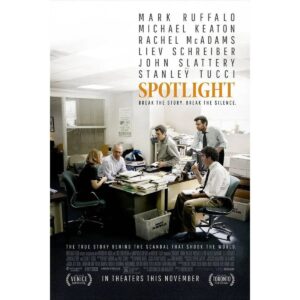
#2 “Spotlight.” In crafting their script about the Boston Globe reporters who revealed the depths of the Catholic Church’s pedophilia scandal, writers Tom McCarthy and Josh Singer followed the “ATPM” stylebook and delivered another brilliant showcase for investigative journalism. The new angle was how the story affected the reporters personally, since some of them had been raised (and remained) Catholic. McCarthy, who also directed, has a stellar cast, including Michael Keaton, Rachel McAdams, Mark Ruffalo, John Slattery, Brian d’Arcy James, Liev Schreiber, and Stanley Tucci. Nominated for six Oscars, “Spotlight” won two — for Best Screenplay and Best Picture.

#3 “She Said.” The story of how New York Times investigative reporters Jodi Kantor (Zoe Kazan) and Megan Twohey (Carey Mulligan) broke the story of Harvey Weinstein’s sexual assaults against up-and-coming actresses and other women who worked for him at Miramax. Even more than the two titles above, “She Said” displays the challenge of getting victims to come forward and tell their stories, and the pain of those who couldn’t because they’d been forced to sign non-disclosure agreements to make their claims go away. Like Pakula, director Maria Schrader doesn’t show her villain, except for one scene towards the end where he is only shot from behind. The other thing “She Said” has in common with “Spotlight” and “ATPM” is that the scandalous behavior at their roots still exists in too many sectors.
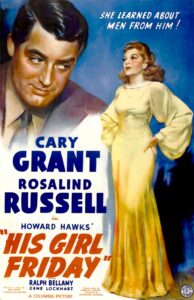
#4 “His Girl Friday.” What began as a stage play, “The Front Page,” was turned into a romance/farce by director Howard Hawks and screenwriter Charles Lederer. Ostensibly about a man who may be hanged for a crime he didn’t commit, “His Girl Friday” is really a dissection of the relationship between a managing editor (Cary Grant) and his ex (Rosalind Russell), who’s about to get remarried (to Ralph Bellamy) and, in doing so, forsake her career as a reporter. With no action sequences to speak of, “His Girl Friday” relies entirely on the words coming out of the actors’ mouths at such a rapid, overlapping pace that I find myself breathless just watching them. Not only that, everyone on screen seems to be having a great time.

#5 “The Paper.” This is Michael Keaton’s other great newspaper movie. He’s the metro editor of a New York tabloid that’s struggling to stay alive amid the pressure to publish scoops. Like the innocent man in “His Girl Friday,” the crime story Keaton and his reporters are covering takes a back seat to his interpersonal relationships with the editor-in-chief (Robert Duvall) and managing editor (Glenn Close). The latter is trying to impose cuts to save money, but that just leads to butting heads with Keaton over what and when to publish. The cast also includes Marisa Tomei as Keaton’s wife (a reporter on leave while very pregnant), Randy Quaid as a schlubby but clever columnist, and Jason Alexander as a bar patron with a chip on his shoulder. Director Ron Howard gives the proceedings a slightly lighter tone than the others on this list, but his style serves the story and its characters well.

#6 “Absence of Malice.” An overreaching prosecutor (Bob Balaban) leaks to a reporter (Sally Field) that a local businessman (Paul Newman) is a suspect in the death of a union leader. Field writes it, her newspaper publishes it, and Newman’s world starts imploding. As she keeps digging up dirt on him, Field uncovers a story about a woman (Melinda Dillon) he knew years ago who’d had an abortion. With no regard for the implications of what she’s doing, Field includes that detail in a followup story. Fed up, Newman turns things inside out and everyone ends up in a conference room with a judge (Wilford Brimley, stealing focus from everyone around him) who is not one bit happy about any of this. Directed with a sure hand by Sidney Pollack, the movie’s only misstep was letting the reporter get involved personally with her subject. Newman, Dillon, and screenwriter Kurt Luedtke were all nominated for Oscars, but came up empty.
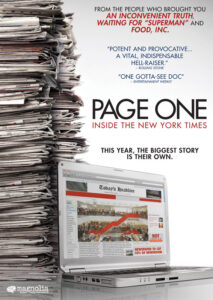
#7 “Page One.” Documentarian Andrew Rossi was given extraordinary access to the inner workings of The New York Times and wisely focuses on the late David Carr, the virtuoso media columnist, as he covers the disruption occurring in his own industry due to the growth of the internet. Meanwhile, other reporters (including Andrew Ross Sorkin and Brian Stelter) are chasing their own stories, diligently working the phones, and — of course — trying to convince people to go on the record. “Page One” is like a crash course in how to do the job of a print reporter while jockeying for space on the front page.
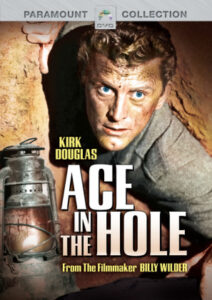
#8 “Ace In The Hole.” Billy Wilder’s 1951 film noir is about a reporter on the outs (Kirk Douglas) who tries to get back into the newspaper business. To do so, he exploits a report of a man trapped in a cave. When a local outlet prints his story and the sheriff gives him exclusive access to the man inside, Douglas uses every trick in the book to take advantage of the circumstances. As newspapers across the country pick up his articles, the gullible public eats up every detail he prints, and soon people flock to the site, create a circus atmosphere, and make both the victim and reporter famous. “Ace In The Hole” is a cynical look at the lengths journalists will go to to keep selling newspapers, and remains just as relevant today with cable news outlets and clickbait websites.
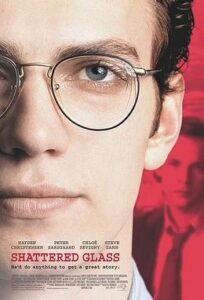
#9 “Shattered Glass.” The story of Stephen Glass, a young journalist who faked more than half of the articles he wrote for The New Republic. Based on a Buzz Bissinger piece in Vanity Fair, “Shattered Glass” stars Hayden Christensen as Glass, with supporting work from Chloë Sevigny, Hank Azaria, Peter Sarsgaard, Steve Zahn, and Melanie Lynskey. Writer/director Billy Ray has a good sense of how to turn a sympathetic character into a man too desperate to please without sensationalizing him or dragging his personal life into it.
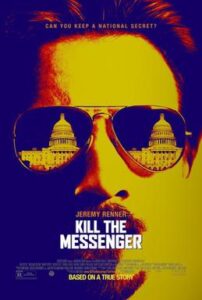
#10) “Kill The Messenger.” A drama based on Gary Webb’s 1996 investigation of the CIA steering large deliveries of crack cocaine to the Black neighborhoods in Los Angeles in the 1980s and using the proceeds to fund the Contras in Nicaragua. Jeremy Renner plays Webb as he moves back and forth between the US and Central America, finding sources and uncovering disturbing details, all while under constant threat from the US government. Renner (who also produced) plays Webb as a hard-edged reporter who’s seen it all but is still surprised by the depths the CIA and other agencies will go to cover their tracks and keep the truth from being revealed.
